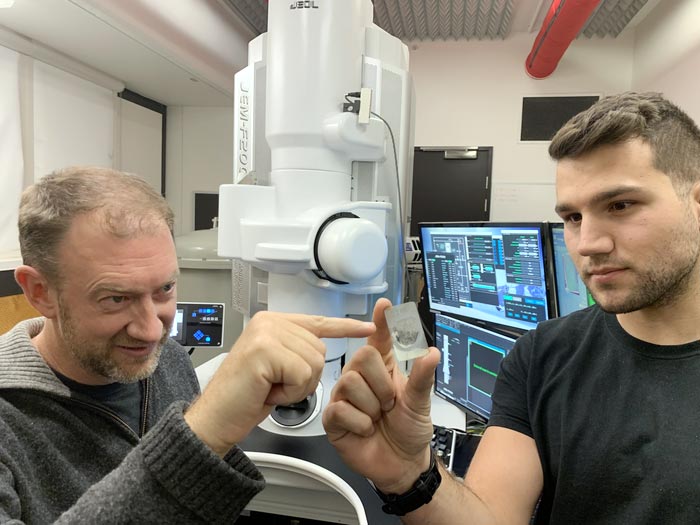Mysterious diamonds came from outer space

Professor Andy Tomkins (left) from Monash University with RMIT University PhD scholar Alan Salek and a ureilite meteor sample.
Credit: RMIT University
Strange diamonds from an ancient dwarf planet in our solar system may have formed shortly after the dwarf planet collided with a large asteroid about 4.5 billion years ago, according to scientists.
The research team says they have confirmed the existence of lonsdaleite, a rare hexagonal form of diamond, in ureilite meteorites from the mantle of the dwarf planet.
Lonsdaleite is named after the famous British pioneering female crystallographer Dame Kathleen Lonsdale, who was the first woman elected as a Fellow to the Royal Society.
The team – with scientists from Monash University, RMIT University, CSIRO, the Australian Synchrotron and Plymouth University – found evidence of how lonsdaleite formed in ureilite meteorites and published their findings in the Proceedings of the National Academy of Sciences (PNAS). The study was led by geologist Professor Andy Tomkins from Monash University.
One of the senior researchers involved, RMIT Professor Dougal McCulloch, said the team predicted the hexagonal structure of lonsdaleite’s atoms made it potentially harder than regular diamonds, which had a cubic structure.
“This study proves categorically that lonsdaleite exists in nature,” said McCulloch, Director of the RMIT Microscopy and Microanalysis Facility.
“We have also discovered the largest lonsdaleite crystals known to date that are up to a micron in size – much, much thinner than a human hair.”
The team says the unusual structure of lonsdaleite could help inform new manufacturing techniques for ultra-hard materials in mining applications.
What’s the origin of these mysterious diamonds?
McCulloch and his RMIT team, PhD scholar Alan Salek and Dr Matthew Field, used advanced electron microscopy techniques to capture solid and intact slices from the meteorites to create snapshots of how lonsdaleite and regular diamonds formed.
“There’s strong evidence that there’s a newly discovered formation process for the lonsdaleite and regular diamond, which is like a supercritical chemical vapour deposition process that has taken place in these space rocks, probably in the dwarf planet shortly after a catastrophic collision,” McCulloch said.
“Chemical vapour deposition is one of the ways that people make diamonds in the lab, essentially by growing them in a specialised chamber.”
Tomkins said the team proposed that lonsdaleite in the meteorites formed from a supercritical fluid at high temperature and moderate pressures, almost perfectly preserving the shape and textures of the pre-existing graphite.
“Later, lonsdaleite was partially replaced by diamond as the environment cooled and the pressure decreased,” said Tomkins, an ARC Future Fellow at Monash University’s School of Earth, Atmosphere and Environment.
“Nature has thus provided us with a process to try and replicate in industry. We think that lonsdaleite could be used to make tiny, ultra-hard machine parts if we can develop an industrial process that promotes replacement of pre-shaped graphite parts by lonsdaleite.”
Tomkins said the study findings helped address a long-standing mystery regarding the formation of the carbon phases in ureilites.
‘Sequential Lonsdaleite to Diamond Formation in Ureilite Meteorites via In Situ Chemical Fluid/Vapor Deposition’ is published in the Proceedings of the National Academy of Sciences (PNAS) (DOI: 10.1073/pnas.2208814119).
IMAGES FOR MEDIA USE
Here’s a link to images related to this story: https://cloudstor.aarnet.edu.au/plus/s/it2S3oiv6tlzS9f
Journal: Proceedings of the National Academy of Sciences
DOI: 10.1073/pnas.2208814119
Method of Research: Observational study
Subject of Research: Not applicable
Article Title: Sequential Lonsdaleite to Diamond Formation in Ureilite Meteorites via Chemical Fluid/Vapor Deposition
Article Publication Date: 12-Sep-2022
Media Contact
Will Wright
RMIT University
will.wright@rmit.edu.au
Cell: 0417510735
All latest news from the category: Physics and Astronomy
This area deals with the fundamental laws and building blocks of nature and how they interact, the properties and the behavior of matter, and research into space and time and their structures.
innovations-report provides in-depth reports and articles on subjects such as astrophysics, laser technologies, nuclear, quantum, particle and solid-state physics, nanotechnologies, planetary research and findings (Mars, Venus) and developments related to the Hubble Telescope.
Newest articles

New model of neuronal circuit provides insight on eye movement
Working with week-old zebrafish larva, researchers at Weill Cornell Medicine and colleagues decoded how the connections formed by a network of neurons in the brainstem guide the fishes’ gaze. The…

Innovative protocol maps NMDA receptors in Alzheimer’s-Affected brains
Researchers from the Institute for Neurosciences (IN), a joint center of the Miguel Hernández University of Elche (UMH) and the Spanish National Research Council (CSIC), who are also part of…

New insights into sleep
…uncover key mechanisms related to cognitive function. Discovery suggests broad implications for giving brain a boost. While it’s well known that sleep enhances cognitive performance, the underlying neural mechanisms, particularly…



